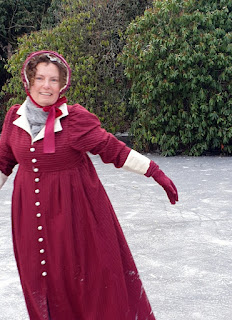And technically the last of 2020, since I cut out the pieces before our New Year's Eve dinner, so that I would have some hand sewing for after dinner.
Yes, 20 years after Ingeborg, Arnaut and I, had the idea to have a 13th century Spanish themed party in the medieval group Nylöse, I am finally starting on a 13th century Spanish outfit.
It really is the best time and region for a themed party: there are lots of period images of clothing, and there are preserved garments, there are cookbooks, books of music to sing and play, and there is of course Alfonso X's "Book of games", so you can be period in everything you do at the event.
Well, the party never happened, but the clothing has been in the back of my head all the time. When I turned 50 I got a gift card from a fabric store from my friend Anna, and spent it on blue silk for the saya encordata, the laced garment you see here:

Being plus size, with 36 G bra size I need to work on the cosntruction of the shift, which will need to give some of the support, and the saya encordata, which will give most of it, so since I am mentally exhausted right now, I started on the simpler of the garments (simpler cut I mean): the pellote.
The book in the frst photo is Clothing the past by Elizabeth Coatsworth and Gale Owen-Crocker. It only covers some of the royal clothing from the las Huelgas monastery in Burgos, but it is very useful. For example it tells us that the pellote I am using as inspiration for the cut was lined with rabbit fur. I actaully have a white rabbit fur coat that used to belong to my mother, and which is older than me. However, even if teh fur is in good shape for being so old, there's no saying how long it will reamin so, and if it's one thing that I hate more than sewing fur it is removing dried out fur which crumbles into fragments.
I could use fake fur, slightly less annoying, but I don't like using fake fur when I am hand sewing and using real silk taffeta (from Puresilks.us), it just feels wrong. So I will probably line it with silk, linen, fustina or even a thin wool. I need to have a look at more of the preserved garments from this time and place before deciding.
The saya encordata above was worn with a pellote (sleeveless surcoat). The one depicted above used the same fabric for both, but there are also examples with contrasting fabric in contemporary art. Just as you see with tunics and surcoats in Europe north of the Alps, though the matchign sets seem to be more popular in Spain and Italy.
These images from the Book of Games show women wearing shifts decorated with embroidery (or woven trim), tight saya encordatas, pellotes, and cloaks.
Red sleeveless saya encordata, blue pellote and blue cloak on the woman to the left. The woman to the right have a more general medieval outfit with a pink gown with gold trim.
The woman to the left is a littel bit unclear, but she might be wearing a dark green saya with sleeves, and a matching cloak, but I need a better photo to see this. The one on the right has a white shift with embroidery, a red saya, red pellote with white trim and a red cloak, probably lined with vair.
The woman to the right wears a red saya encordata with sleeves and gold trim along the arms and around the wrists. She has a light blue pellote with striped trim, and no cloak. The woman to the left wears some kind of Muslim dress.
One woman and at least one man, probably the other one too, judging from the fit, wear a saya encordata. The woman furthest to the left might be wearing a looser tunic in pink with her blue pellote, but the woman playing wears a white shift with embrodiered or woven trim, a red, sleeveless saya encordata, a blue pellote, and a red cloak, draped over her lap.
The woman to the right wears a white shift with black trim, a pinkish saya encordata and a light blue pellote with white and black trim.
This woman wears a sleeved saya, it is unclear if it is tight and laced or not, and a green pellote and cloak, both with white and black trim.
Here we see a white shift which only trim is two rows of black tape or cord at the sleeves. The saya has no visible lacing, but is very tight, and the pellote is a greyish blue with white and black trim.
Anyway, this far I have sewn most of the seams on the pellote and now I have to decide on whether to line it before hemming.
And I really want an SCA event to wear it to.
























